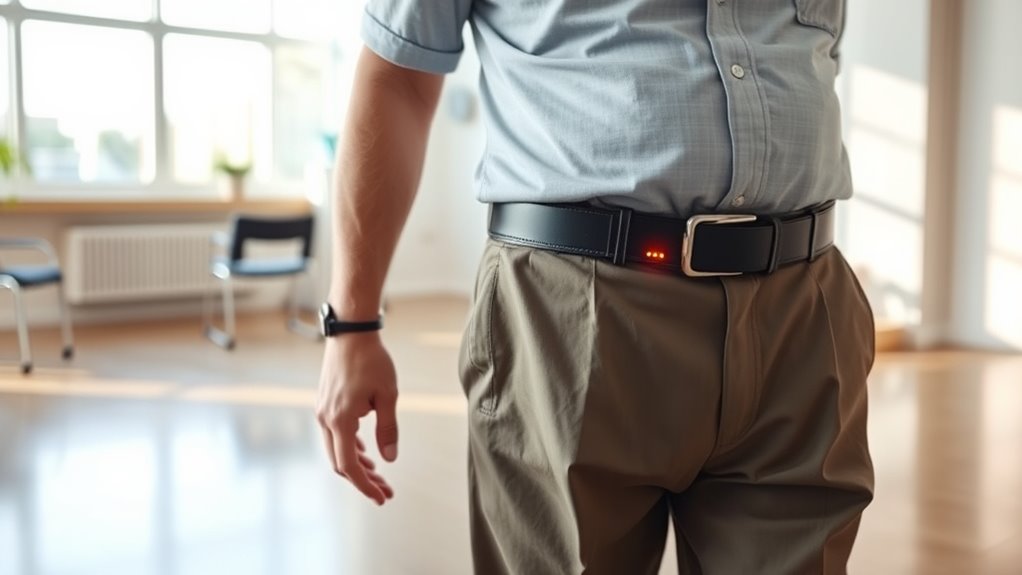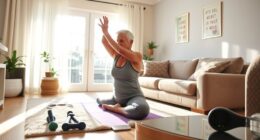Cueing devices can help improve your gait by providing external prompts that keep you moving steadily. Options include auditory cues like rhythmic music or metronomes, visual cues such as floor markers or laser lines, and tactile signals like vibrations. Advanced wearables and smartphone apps also track your progress and offer real-time feedback. Choosing the right device depends on your preferences and lifestyle, and exploring more will show you how these tools can support your mobility and confidence.
Key Takeaways
- Visual cues like floor markers and laser lines help initiate and maintain steady gait in Parkinson’s patients.
- Auditory cues such as metronomes and rhythmic music assist in regulating walking pace and reducing freezing episodes.
- Tactile devices like vibrations and vibrotactile bracelets provide external prompts to improve stride consistency.
- Integrated technology offers real-time feedback, personalization, and progress tracking to enhance gait stability.
- Selecting portable, easy-to-use cueing devices tailored to individual routines supports confidence and promotes safe walking.
Types of Cueing Devices for Parkinson’s

There are several types of cueing devices available to help improve gait in people with Parkinson’s disease. You might use auditory cues, like metronomes or rhythmic music, to help set a steady walking pace. Visual cues, such as laser lines projected onto the floor, can guide your steps and improve stride length. Tactile cues, like vibrations or handheld devices, provide physical prompts to maintain rhythm. Some devices combine these cues for a more all-encompassing approach. The goal is to give your brain external signals that support smoother, more coordinated movements. Incorporating external stimuli such as cueing devices can help optimize gait and reduce motor fluctuations. These devices utilize sensor technology to detect movement patterns and deliver cues precisely when needed, enhancing their effectiveness. The use of safety features such as automatic shut-off and real-time monitoring can also improve user confidence and prevent potential hazards. Additionally, personalization options allow users to tailor cues to their specific gait patterns, increasing the likelihood of success. Choosing the right device depends on your specific needs and preferences, but all aim to reduce gait disturbances and increase mobility. These tools can make walking more manageable and boost your confidence.
How Visual Cues Enhance Gait Stability

Visual cues can substantially enhance gait stability in individuals with Parkinson’s by providing clear, external references that guide movement. When you use visual cues, such as lines on the floor or contrasting markers, they give your brain a concrete target to focus on, helping you initiate and maintain a steady stride. These cues reduce hesitation and freezing episodes by making your walking pattern more predictable. For example, stepping over a painted line or following a marked pathway can improve your stride length and rhythm. Visual cues also increase your awareness of your surroundings, encouraging more confident and purposeful movements. Additionally, incorporating data-driven strategies can help tailor cues to individual needs for optimal results. Recognizing the importance of external references can further enhance gait improvements and safety. For instance, understanding how wind energy capacity factors influence renewable energy integration underscores the importance of tailored cues. Overall, they serve as effective tools to reinforce gait patterns, making walking safer and more stable. Using individualized cues can further maximize the effectiveness of these interventions by adapting to each person’s specific gait challenges and leveraging personalized feedback for continuous improvement.
The Role of Auditory Cues in Movement Improvement
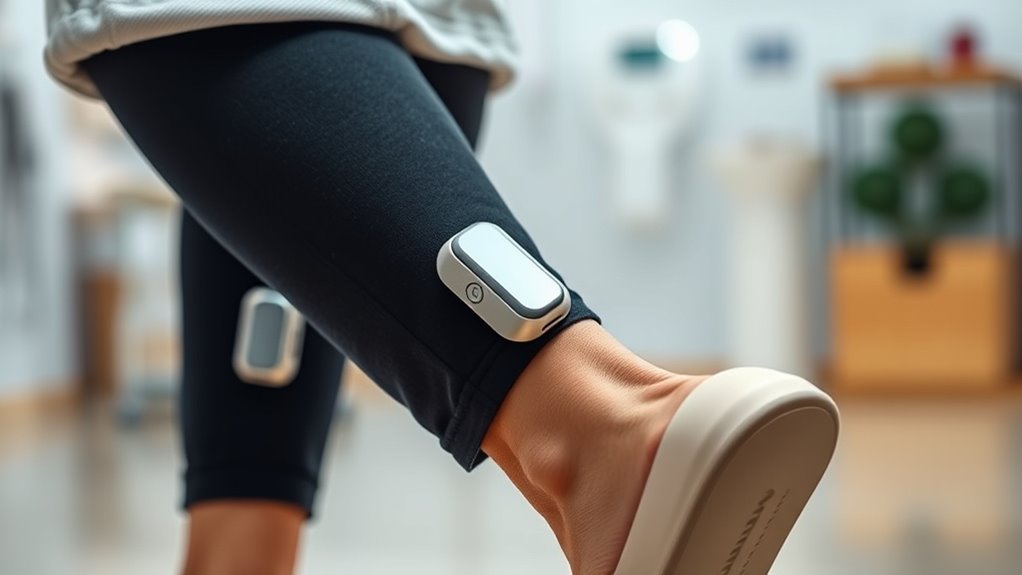
Auditory cues play a crucial role in improving movement for individuals with Parkinson’s by providing rhythmic signals that help regulate gait. These cues, such as metronomes or rhythmic music, give your brain a consistent tempo to follow. This external rhythm can reduce freezing episodes and improve stride length, making walking smoother and more confident. When you synchronize your steps with the beat, it helps bypass impaired internal timing mechanisms in your brain. Auditory cues are especially effective because they’re easy to implement and can be used in everyday settings. They create a predictable pattern that encourages more regular movement, decreasing hesitation and fall risk. Incorporating rhythmic sounds into your walking routine leverages sensorimotor synchronization to help regain a sense of control and improve overall mobility. Additionally, understanding how brain mechanisms respond to external cues can further enhance personalized intervention strategies.
Tactile Cues and Their Impact on Walking Patterns
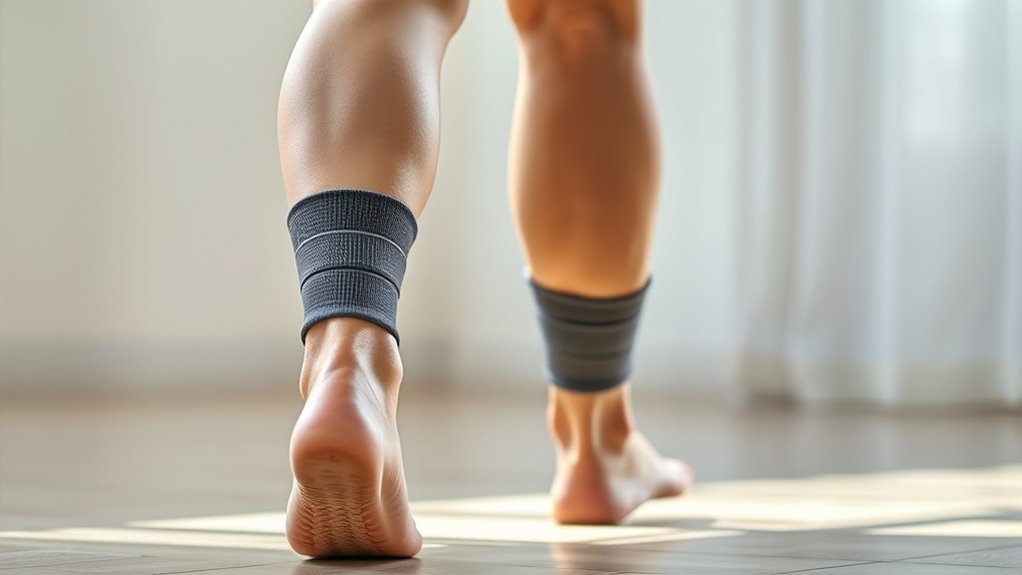
Tactile cues can help you improve your walking by enhancing your gait rhythm and keeping you steady. They also may reduce freezing episodes, making movement smoother and more predictable. With consistent use, tactile cues can boost your confidence to walk more comfortably and safely. Incorporating self-watering plant pots into your daily routine can serve as a calming activity that promotes mindfulness and reduces stress, which may positively influence your gait stability.
Enhancing Gait Rhythm
Because Parkinson’s disease often disrupts the natural rhythm of walking, using tactile cues can help restore a more consistent gait pattern. When you tap into tactile cues, such as rhythmic vibrations or vibrations synchronized with your steps, they serve as an external metronome. This external rhythm guides your movements, helping you maintain a steady pace. Consistent rhythm improves your overall gait stability and reduces hesitation or irregular steps. By focusing on the tactile stimuli, you can bypass some of the internal timing issues caused by Parkinson’s. Over time, this external pacing helps reinforce a smoother, more natural gait. Incorporating tactile cues into your walking routine can make your gait more rhythmic, confident, and less affected by the unpredictability of the disease.
Reducing Freezing Episodes
Tactile cues can play a crucial role in reducing freezing episodes during walking by providing clear, external signals that help you break through momentary blocks. These cues act as gentle prompts, guiding your steps when your mind feels stuck. When you experience freezing, tactile cues can:
- Instantly alert you to restart movement, preventing prolonged hesitation.
- Reinforce a steady rhythm, helping you regain confidence.
- Create a sense of connection, reducing feelings of isolation and frustration.
Boosting Movement Confidence
When you use tactile cues during walking, they can markedly boost your confidence by providing clear, external signals that reinforce your movement. These cues act as tangible reminders, helping you feel more in control and less uncertain about your steps. As a result, you’re likely to walk more steadily and with greater assurance. Tactile cues, like vibrations or touch-based prompts, reduce hesitation and decrease the fear of falling, which often hampers gait. Over time, consistent use can improve your overall walking pattern by fostering trust in your movements. Feeling more confident encourages you to walk more naturally and independently, enhancing your sense of autonomy. Ultimately, tactile cues serve as practical tools to reinforce your belief in your ability to walk securely.
Integrating Technology: Wearables and Smartphone Apps
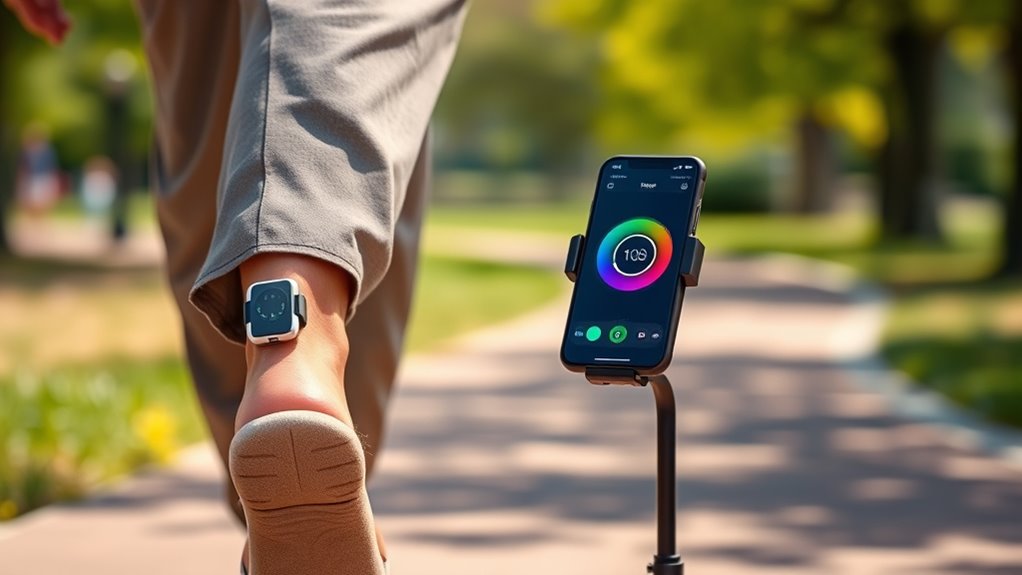
Integrating technology into gait management offers promising opportunities for individuals with Parkinson’s disease. Wearables and smartphone apps can provide real-time cues, track progress, and motivate you to stay active. These tools help you feel more in control of your movement challenges. With just a tap or a glance, you can access personalized feedback that encourages consistent walking patterns. Imagine:
Harness technology to stay active, track progress, and boost confidence in managing Parkinson’s gait challenges.
- Receiving gentle vibration alerts to prompt stepping when you hesitate.
- Monitoring your gait improvements over time to celebrate progress.
- Accessing tailored exercises and reminders directly from your device. Incorporating advanced sensor technology can further enhance the accuracy and responsiveness of these devices. These innovations make managing symptoms more accessible and empowering. By seamlessly integrating into your daily routine, they help you maintain independence and confidence in your mobility journey. Real-time feedback from these devices can also facilitate immediate adjustments to your walking patterns, promoting better gait quality. Technology becomes your supportive partner, guiding you step by step. Additionally, understanding remote hackathons can foster the development of new assistive technologies through collaborative innovation, accelerating solutions like these devices. Incorporating best anime movies can also provide enjoyable distraction and motivation during your rehabilitation. Moreover, advancements in portable electronic devices ensure these tools are lightweight and unobtrusive, making them easier to use throughout your day.
Choosing the Right Cueing Device for Your Needs
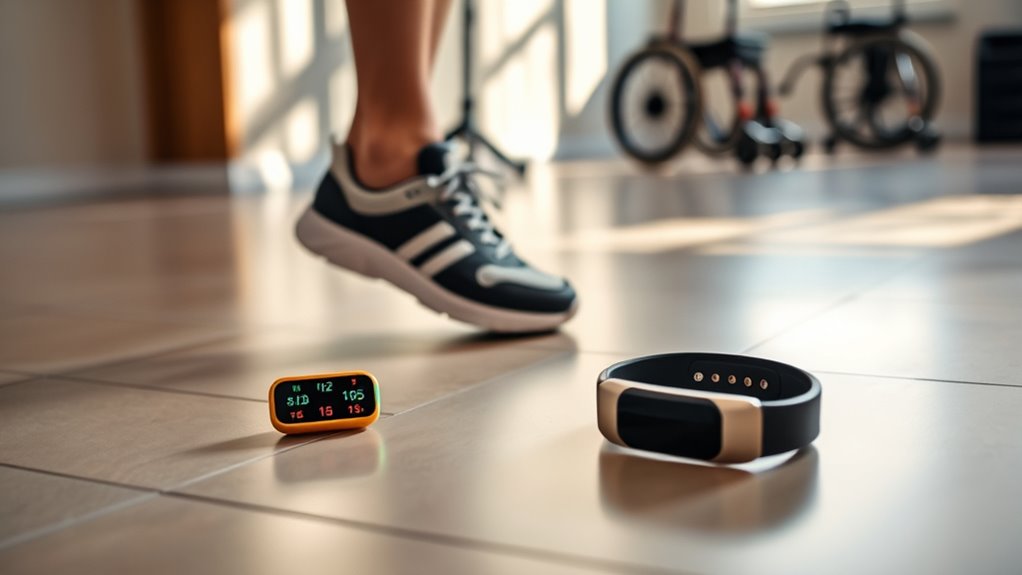
Choosing the right cueing device depends on your specific needs and daily routine. Consider the different types available and how their benefits align with your lifestyle. By understanding your preferences, you can find a device that effectively supports your gait. Additionally, integrating good lighting into your routine may help develop new strategies for managing gait difficulties. Incorporating automation technology in your environment may also assist in creating consistent cues and improving mobility.
Device Types and Benefits
Selecting the right cueing device depends on your specific needs and preferences, as different options offer distinct advantages. Each device type can boost your confidence and help you regain mobility. For example:
- Auditory cues—like metronomes or rhythmic beats—can inspire you to match your steps and restore rhythm.
- Visual cues, such as laser lines or floor markings, provide clear targets, encouraging steady gait.
- Tactile cues, like vibrating devices or wearable metronomes, offer discreet prompts, helping you stay focused without distraction.
Choosing the right device can make movement smoother, reduce falls, and give you back a sense of control. It’s about finding the tool that resonates with your unique needs and empowers you to move confidently every day.
Personal Preferences and Lifestyle
Since everyone’s daily routine and personal preferences vary, finding a cueing device that fits seamlessly into your lifestyle is vital. Consider how you like to move and what environments you’ll use the device in. If you’re active outdoors, a portable, durable cue might suit you best. If you prefer discreet options, look for devices that are small or hidden, like a vibrotactile bracelet. Ease of use is also essential—if you dislike complicated setups, choose something simple and intuitive. Think about your comfort level; some devices might be bulky or distracting, while others are lightweight. Matching the device to your daily habits and comfort ensures you’ll actually use it consistently, which is key to improving your gait and maintaining independence.
Frequently Asked Questions
How Do Cueing Devices Affect Long-Term Mobility in Parkinson’S Patients?
You might wonder how cueing devices influence long-term mobility in Parkinson’s patients. These devices help by providing external cues that improve gait and movement patterns. Over time, they can enhance stability, reduce falls, and promote independence. While they don’t cure the disease, consistent use can reinforce better walking habits, potentially leading to sustained mobility improvements. Your ongoing use and proper management are key to maximizing these benefits.
Can Cueing Devices Be Customized for Individual Gait Patterns?
Oh, sure, because everyone’s gait is a perfect fingerprint, right? You can absolutely customize cueing devices for individual gait patterns, making them as unique as your morning coffee order. By analyzing your specific movement quirks, developers tailor these devices to boost mobility precisely where you need it. So yes, with some tech wizardry, cueing devices can be personalized, helping you regain confidence and stride with purpose.
Are There Any Side Effects or Risks Associated With Using Cueing Devices?
You’re wondering if using cueing devices has any side effects or risks. While these devices are generally safe, some users might experience minor issues like skin irritation from wearable components or discomfort from constant use. In rare cases, devices could cause falls if they malfunction or distract you. To minimize risks, follow instructions carefully, get professional guidance, and regularly check your device’s condition. Always discuss concerns with your healthcare provider before starting new aids.
How Cost-Effective Are Different Cueing Options for Patients?
Did you know that many cueing devices can substantially reduce fall risks in Parkinson’s patients? When considering cost-effectiveness, you’ll find simple options like auditory cues, such as metronomes, are often affordable and easy to use. More advanced devices, like wearable sensors, might cost more initially but can save money long-term by improving mobility and reducing injury costs. Overall, choosing a device depends on balancing effectiveness with your budget.
What Training or Support Is Needed to Effectively Use Cueing Devices?
To use cueing devices effectively, you need proper training and ongoing support. You should learn how to operate the device, interpret cues, and adjust settings as needed. Healthcare professionals can guide you through initial setup and teach you techniques to integrate cueing into your daily routine. Regular follow-ups guarantee you’re using the device correctly and help troubleshoot any issues, maximizing benefits and maintaining your confidence in using these tools.
Conclusion
By weaving cueing devices into your daily routine, you create a steady rhythm that guides your steps like a reliable drumbeat. Visuals, sounds, and touches become your personal compass, turning uncertain pathways into clear, confident journeys. As you embrace this symphony of cues, each stride gains strength and purpose. With patience and the right tools, you’ll find your gait flowing smoothly, transforming challenges into a dance of resilience and hope.
